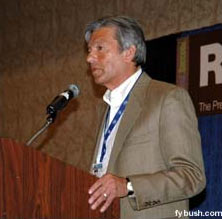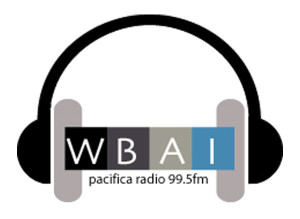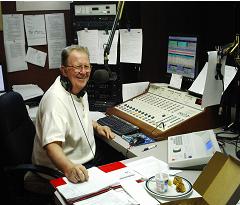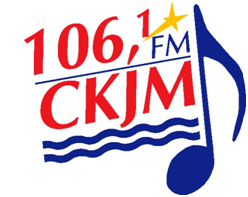NorthEast Radio Watch 3/31/2025: Jim Quinn Signs Off
In this week’s issue… Remembering Pittsburgh's Quinn - Seven Mountains enters Harrisburg - My launches new brands - Ryan out at B101 - More cuts at Radio Vermont - Another AM deleted
In this week’s issue… First LPFM applicant hits air – WBUR adds new Cape signal – Whither Scott Shannon and WOR? – Classical stations cut back – NJ aux tower survives NIMBY onslaught – Veteran PA host dies
By SCOTT FYBUSH
*How fast can a low-power FM station hit the air after getting its construction permit granted? In MASSACHUSETTS, the answer appears to be “wicked fast,” at least if the station in question is WXBJ-LP (94.9 Salisbury). “Good Neighbor Station, Inc.” filed its application on November 12, 2013, had the application accepted for filing on November 25, was granted its CP on February 3, and on Saturday afternoon at 3 the new station hit the airwaves along the New Hampshire border.
 WXBJ isn’t quite the first station to hit the air from the 2013 LPFM window – that honor appears to belong to a station in Utah – but it’s certainly the first in NERW-land to begin broadcasting. Its filing with the FCC says the new station will focus on issues affecting local senior citizens, and so far there’s only a makeshift website providing a live stream of the new station.
WXBJ isn’t quite the first station to hit the air from the 2013 LPFM window – that honor appears to belong to a station in Utah – but it’s certainly the first in NERW-land to begin broadcasting. Its filing with the FCC says the new station will focus on issues affecting local senior citizens, and so far there’s only a makeshift website providing a live stream of the new station.
*While WXBJ-LP jumped from application to on-air license in just a few months, a full-power CP on Cape Cod is being sold with just a few weeks left before its permit expires. Home Improvement Ministries applied for 89.1 in Brewster in the 2007 window for non-commercial FM applicants and was granted its permit on April 14, 2011. If the station doesn’t get on the air by April 14, 2014, its permit will expire – and that’s why Home Improvement just sold the permit to Boston University’s WBUR (90.9 Boston) for just $7500.
WBUR has a project ahead of it: instead of the planned 23 kW/285′ signal (which would actually have been on the Outer Cape, on a new tower near the Eastham-Wellfleet line), it will soon be applying for a more minimal facility to get the signal on the air ahead of the deadline. If it can get its new station built, the new 89.1 will join WBUR’s existing relays on the Cape, WBUA (92.7 Tisbury) from Martha’s Vineyard, serving the lower Cape, and WCCT (90.3 Harwich), the Cape Cod Tech station that carries most of WBUR’s schedule to the mid-Cape.
 While we’re out on the Cape, we note that CodComm has been doing some tweaking at its adult hits “Frank” (WFRQ 93.5 Dennis), adding a lineup of personalities to a station that’s been jockless since its debut back in 2006. Jenn Kennedy moves from weekends on sister station WPXC (102.9) to mornings on “93.5 Frank,” followed by the veteran talent Bumper Morgan in middays and Janet Birchfield in afternoons. Frank carries the syndicated John Tesh in evenings.
While we’re out on the Cape, we note that CodComm has been doing some tweaking at its adult hits “Frank” (WFRQ 93.5 Dennis), adding a lineup of personalities to a station that’s been jockless since its debut back in 2006. Jenn Kennedy moves from weekends on sister station WPXC (102.9) to mornings on “93.5 Frank,” followed by the veteran talent Bumper Morgan in middays and Janet Birchfield in afternoons. Frank carries the syndicated John Tesh in evenings.
[private]
Off the Cape, WYQQ (90.1 Charlton) needs to move, and fairly quickly. The former WBPV maintained its transmitter site on the roof of Bay Path Vocational School after the school sold the license back in 2003, but the ten-year lease on the Bay Path tower is up and the school wants the transmitter moved. WYQQ’s proposing to go from its present 100 watts/390′ at Bay Path to 120 watts/262′ from a tower just to the north, alongside the Mass Pike.
Back to the world of LPFMs – and to the Cape – new grants last week included 103.5 Yarmouth, to Cape Cod Catholic Broadcasting, as well as 105.9 Athol, to Athol Orange Community Television.
*In RHODE ISLAND, Rob Anthony adds operations manager/PD duties for Clear Channel’s four-station cluster (WSNE, WHJY, WWBB and WHJJ) to his extensive existing responsibilities as regional programming manager for Clear Channel’s Manchester, Portsmouth, Springfield and Worcester clusters.

On TV, Jim Taricani has been as aggressive as they get when it comes to chronicling organized crime and the prodigious corruption in the Ocean State’s government. Back in 2005, he served four months of a six-month sentence of home confinement after refusing to reveal a source who gave him information for his coverage of the investigation that led to the conviction of mayor (and later WPRO talk host) Buddy Cianci. (Taricani was honored at the NAB Show in Las Vegas immediately after his release, a story we covered in NERW on April 25, 2005.)
After 32 years with WJAR (Channel 10), Taricani announced last week that he’s resigning, effective April 1, ending one of the longest runs of any investigative reporter in the country. The 64-year-old Taricani, who received a heart transplant in 1996, says he’s stepping back, but not completely – he’s going to partner with a former WJAR colleague, Dyana Kelsch, at her communications firm.
His departure from WJAR comes at a somewhat curious moment for the station: the Media General-owned NBC affiliate is fighting a grievance filed by just-dismissed reporter Julie Tremmel. It is, perhaps, a sign of the generational shift in local TV news that while Taricani achieved renown for hard-hitting investigative reporting, Tremmel became internet-famous for a light-hearted piece last year on the fear of bear attacks that was sweeping the state. (Taricani entered the picture when he posted a Facebook comment calling the story a “smudge on our station’s reputation.”)
Tremmel’s dismissal last week reportedly followed another light feature story in which she did an on-camera handstand while reporting on an “America’s Got Talent” audition. She’d been with WJAR for 15 months, and had worked for WWLP (Channel 22) in Springfield before that.
*In MAINE, Dick Gleason’s Mountain Valley Broadcasting has completed its $35,000 purchase of W288CW (105.5 Lewiston) from Edgewater Broadcasting, providing an FM outlet for “EZ1240,” Gleason’s WEZR (1240 Lewiston).
Over at Binnie Media’s Portland cluster, Corey Garrison has departed the afternoon slot at “Wolf” WTHT (99.9 Auburn)/WBQQ (99.3 Kennebunk) after eight years on the job; PD Stan Bennett takes over the airshift there.
*An odd collision of applications in northern NEW HAMPSHIRE still hasn’t been resolved. On the LPFM side, there’s the Boys and Girls Club’s newly-granted 89.1 in Lisbon, which has just picked up a callsign (WNHB-LP). But just before the FCC granted the LPFM application, it accepted another application for filing – a minor change to upgrade Barry Lunderville’s WSSH (89.7 Lisbon) from its present 130 watts to 5,000 watts, with a move to 89.3. Because LPFM is an unprotected secondary service, the WSSH application didn’t have to take the 89.1 LPFM application into consideration, but its application did create impermissible interference to Vermont Public Radio’s WVPR (89.5 Windsor), so it’s now been modified to specify 4,000 watts instead. If it’s granted, will WNHB-FM have to move before it even gets on the air?
In Manchester, the end of the line is approaching for veteran WZID (95.7) morning man Mike Morin, who’s planning to leave the Saga station in May. That’s kicked off a job hunt for a replacement, and WZID is eagerly looking for the right person for this rare opportunity. How rare? Morin’s coming up on 12 years on the job – and 43 years in radio. (And he turns 63 on Thursday – happy birthday!)
*Just across the state line in Hartford, VERMONT, WMVY (104.3) came back on the air last Wednesday as owner Electromagnetic Company works to keep the signal alive while awaiting a move to the Burlington market and presumably a sale. One of the castoffs from Nassau Broadcasting’s exit, WMVY (then WWOD) went silent on December 5, 2012 and returned to the air from October 29 until December 2, 2013, running a filler format of movie music. This time, we hear old-time radio is the format of choice for WMVY’s (presumably temporary) return.

Vermont Public Radio’s “VPR Classical” service has eliminated one of its local on-air hosts. Joe Goetz, who’d hosted weekday afternoons on the network since 2007, was let go last week, leaving the syndicated Classical 24 service filling the afternoon hours for now. As part of a three-year strategic plan adopted in 2013, VPR says it’s planning to hire a “managing producer” for the service who’ll also host afternoons alongside existing hosts Kari Anderson and Walter Parker. (And keep reading – that’s not the only change in classical radio staffing across the region this week…)
*In CONNECTICUT, two more LPFM construction permits were granted last week: in Terryville, just west of Bristol, the Riverside Baptist Church will be on 105.3, while in Avon, the Valley Community Baptist Church will be on 106.3. In Willimantic, the new 100.1 takes calls WCFV-LP.
On the commercial end of things, the week brought some new developments in the long-running investigation of WTIC (1080 Hartford) afternoon host and former governor John Rowland, who served time in federal prison on fraud charges after resigning from office a decade ago. The latest kerfuffle involves Rowland’s advocacy for a congressional candidate in 2012. During the Republican primary for the 5th district seat, Rowland was vocal on the air in his support of candidate Lisa Wilson-Foley, and he’s been under investigation since it emerged that Wilson-Foley’s husband was paying Rowland $30,000 to serve as a a consultant to his chain of rehab centers. This week, the Hartford Courant reported that Brian Foley has agreed to cooperate with federal investigators – and the New Haven Register‘s editorial page called on WTIC to take the “long-overdue” move of firing Rowland.
(How influential is talk radio? Perhaps not so much – Wilson-Foley lost her primary, and the seat went Democratic in November.)
 *There’s a strong Connecticut connection to the newest radio station serving Palm Beach County, Florida. WLML (100.3 Lake Park) was the result of the most recent FCC auction of FM channels, and the winning bidder last May was Connecticut School of Broadcasting founder Dick Robinson and his family, doing business as Robinson Entertainment. WLML signed on last week with a standards format as “Legends 100.3,” featuring Robinson himself at night and another Connecticut name, longtime broadcaster Walt Pinto, in middays.
*There’s a strong Connecticut connection to the newest radio station serving Palm Beach County, Florida. WLML (100.3 Lake Park) was the result of the most recent FCC auction of FM channels, and the winning bidder last May was Connecticut School of Broadcasting founder Dick Robinson and his family, doing business as Robinson Entertainment. WLML signed on last week with a standards format as “Legends 100.3,” featuring Robinson himself at night and another Connecticut name, longtime broadcaster Walt Pinto, in middays.
*It appears NEW YORK‘s WOR (710) is headed for a second week of fill-in morning hosts after the abrupt end to its “Elliot in the Morning” simulcast with Washington’s WWDC-FM (101.1).
 In a NERW Extra last week (remember, NERW’s updated more often than just Mondays – follow us on Twitter and Facebook for additional NERW content!), we explored some of the back story behind the move and filled in some of the gaps in the gossip – yes, Elliot Segal was meant to be a permanent part of WOR, not just a “palate-cleanser” to wipe out the old morning audience – and analyzed the pros and cons of adding recently-deposed WPLJ morning man Scott Shannon to the WOR lineup.
In a NERW Extra last week (remember, NERW’s updated more often than just Mondays – follow us on Twitter and Facebook for additional NERW content!), we explored some of the back story behind the move and filled in some of the gaps in the gossip – yes, Elliot Segal was meant to be a permanent part of WOR, not just a “palate-cleanser” to wipe out the old morning audience – and analyzed the pros and cons of adding recently-deposed WPLJ morning man Scott Shannon to the WOR lineup.
And as of Sunday night, that’s still all we know. While another legacy New York morning man, WABC’s Don Imus, sparked a new round of rumors by dropping an on-air “congratulations” to Shannon for landing the WOR job, it’s all just rumors for now. And the longer the rumors drag on, the clearer it becomes that whatever’s happening at WOR, even if Shannon does end up as the morning man there, it’s not the result of a carefully-constructed plan by Clear Channel. (We stand by our observations here at NERW: it appears to us that Clear Channel still has more to gain from a Shannon-on-WOR arrangement than does Shannon himself.)
One change we can confirm from New York is the return of veteran WABC producer Jill Vitale after a two-year-plus absence from the station. The former Sean Hannity producer, who became a part of the show under her nickname “Flirty Flipper,” is the new producer of WABC’s Curtis and Kuby midday show, and she’s also taking some credit for having reunited the duo when she started a conversation between them at a party late last year.
*However chaotic and confusing the situation at WOR might be, it still can’t hold a candle to the slow-motion disaster that is WBAI (99.5), where any consideration of entering into a “Public Service Operating Agreement” (the noncommercial version of an LMA) with a competent broadcaster has now been put off for at least two more months. That was just one of the bits of news from the open letter that WBAI’s inexplicably resilient general manager Berthold Reimers put out on Friday.
 “We are now in crisis mode,” Reimers said in what may be the most obvious statement ever made by a station manager; at the same time, he says WBAI’s financial picture has actually improved slightly thanks to fundraisers in October and December that finally paid off the last of the money the station owed on its ill-advised (and now vacated) Wall Street studio space. Those successful fundraisers, Reimers says, means WBAI no longer has to turn to Pacifica’s depleted national coffers just to make payroll – and he says that’s persuaded Pacifica’s national board to give the local management that 60-day extension before considering a PSOA.
“We are now in crisis mode,” Reimers said in what may be the most obvious statement ever made by a station manager; at the same time, he says WBAI’s financial picture has actually improved slightly thanks to fundraisers in October and December that finally paid off the last of the money the station owed on its ill-advised (and now vacated) Wall Street studio space. Those successful fundraisers, Reimers says, means WBAI no longer has to turn to Pacifica’s depleted national coffers just to make payroll – and he says that’s persuaded Pacifica’s national board to give the local management that 60-day extension before considering a PSOA.
Beyond that, it’s the usual chaos: while giving lip service to the idea that “of course we all want to get away from WBAI’s undue reliance on premiums,” Reimers acknowledges that WBAI is already back to its undue reliance on Gary Null and his health nostrums to raise money, calling Null’s two-week absence from the WBAI schedule “unfortunate.” (And in good WBAI fashion, while Reimers says the “program is the premium” experiment was a failure, a big ad for “The Program is the Premium” is still in the lead-off spot on the station’s website.)
About those premiums? Reimers admits that WBAI has fallen woefully behind in delivering the tchotchkes it’s promised to listeners, though he says volunteers are trying hard to catch up. Also behind schedule (and perhaps more of a concern for donors and would-be donors) is the delivery of tax forms to those expecting to be able to claim deductions.
Will WBAI really turn a corner by the time Pacifica’s national board reconsiders the PSOA in April? We’ve got a bottle full of snake oil available as a pledge premium for anyone who believes it will…
*On Long Island, Connoisseur is hoping today’s return of WKJY (98.3 Hempstead) morning hosts Steve Harper and Leeana Karlson is a low-key one. Harper (who’s also the PD at “K98.3”) and Karlson served a one-week suspension after news broke that they’d faked a homophobic RSVP note in hopes of provoking an on-air discussion. Connoisseur says it made the decision to allow Harper and Karlson back on the air after a series of meetings with area LGBT groups.
 *In Ithaca, it appears a new permanent lineup is in place at Saga’s Cayuga Radio Group following the acquisition of ROI Broadcasting’s WFIZ (95.5 Odessa) and its two translators. The latest changes found W254BF (98.7), the former home of AAA “the Vine,” relaunching last Monday as “98.7 the Buzzer,” a sports challenger to the last remaining fully-commercial challenger in the market, Todd Mallinson’s WPIE (1160 Trumansburg) and its Ithaca FM translator at 107.1.
*In Ithaca, it appears a new permanent lineup is in place at Saga’s Cayuga Radio Group following the acquisition of ROI Broadcasting’s WFIZ (95.5 Odessa) and its two translators. The latest changes found W254BF (98.7), the former home of AAA “the Vine,” relaunching last Monday as “98.7 the Buzzer,” a sports challenger to the last remaining fully-commercial challenger in the market, Todd Mallinson’s WPIE (1160 Trumansburg) and its Ithaca FM translator at 107.1.
While WPIE has ESPN Radio, the new “Buzzer” carries CBS Sports Radio, Cornell basketball (its lone local offering) and Bills football, fed from an HD subchannel of WYXL (97.3). Up the dial, the former “Hits 103.3” (W277BS) has ended its temporary simulcast with former top-40 competitor WFIZ. Now that “Z95.5” is part of Saga instead of a competitor, 103.3 has been returned to its original purpose as an in-town translator of country WQNY (103.7), which has a spotty signal in parts of the city from its Connecticut Hill tower site.
If you’re keeping score at home, here’s what the massive cluster of translators and full-power signals now looks like, as best we can tell, with 15 signals in all carrying nine program streams, all perfectly legally:
Up at the other end of Cayuga Lake (and a smidge to the east), Craig Fox has silenced another of his AM signals. WMBO (1340 Auburn) had spent the last few years simulcasting Radio Disney with WOLF (1490 Syracuse), but it flipped to an all-Christmas format in October, followed by an all-Beatles stunt format after the holidays. Now there’s word that 1340 has fallen silent, just a couple of weeks after 1490 dropped Disney and went dark. Unlike WOLF, which has filed for a silent STA with the FCC, there’s been no filing yet for WMBO.
*It was a relatively slow week for LPFM grants across the Empire State, with just two new CPs: near Utica, Lifepoint Church of the Mohawk Valley gets 97.3 in Whitesboro, while Birds of a Feather Media Ltd. gets 104.1 in Woodstock. Close to home here in Rochester, MuCCC’s newly-granted 104.3 applies to move to the East Main Street tower site of WJZR (105.9), while Grace Bible Fellowship’s 98.3 in Fairport gets the callsign WZNY-LP.
And we note the passing of Garrick Utley, who spent 30 years as a versatile foreign correspondent and anchor with NBC News, including several stints as New York-based weekend anchor for NBC Nightly News. After leaving NBC in 1993, Utley worked for ABC and CNN before going into academia, and in recent years he’d been part of the SUNY system, serving as president of the Neil D. Levin Graduate Institute of International Relations and Commerce in Manhattan and teaching journalism at SUNY Oswego. Utley died Thursday in Manhattan, at age 74.

*Our PENNSYLVANIA news begins with the death of longtime Carlisle morning man Ben Barber. A fixture in the market from 1966 until his retirement just last year, Barber was with WHYL (960) until 1979, when he went across town to WIOO (1000) before returning to WHYL in 2004. Barber’s departure from WHYL came in the midst of the station’s bankruptcy, though he said his main reason for leaving was age and health. In all, Barber spent 50 years on the radio, including early stints in Elizabethtown and at Harrisburg’s WCMB (1460); he was also a popular event DJ in the area for many years. Barber, whose real name was Ben Shatto, was 70 when he died last Tuesday; his widow, Donna, says he’d been fighting bladder cancer for two years.
We also note the passing of Bruce Holcomb, a veteran radio and TV personality in central Pennsylvania. After starting his broadcast career in the 1960s in Reading (program director at WRAW) and Ephrata (sports director at WGSA/WIOV), Holcomb moved to Harrisburg’s WHP (580/97.3) and WHP-TV (Channel 21) in 1970. In more than two decades there, he anchored the news on WHP-TV and did mornings (as “The Country Gentleman”) on WHP radio. Holcombe also had a long run as a sports announcer, including serving as the first PA announcer at the City Island baseball park. Holcombe died February 14 after a long illness.
*Pittsburgh’s WQED (89.3) is the other classical station in the region making headlines this week for its attempts to adjust to a challenging budget climate. Starting next week, WQED says it will cut back the airshifts of several of its local personalities, reducing what are now five-hour airshifts to three hours each. Morning host Jim Cunningham will go off the air at 9, midday host Anna Singer will end her show at 2 PM and afternoon host Ted Sohier will go off the air at 7 PM. Just as in Vermont, the syndicated Classical 24 will fill the new 9-11 AM and 2-4 PM gaps; the service already runs on WQED overnight and will now start at 7 PM instead of 9 PM. WQED says it’s cut two back-office jobs, one through early retirement and the other in a layoff, to focus more of its limited resources on the on-air product.
In the Scranton market, Tori Thomas is Kenny Wall’s replacement as PD of WBSX (97.9 Hazleton), where she’s also holding down afternoon drive on-air duties. Thomas moves up the Turnpike extension from Allentown, where she spent 16 years at WZZO (95.1) before joining Cumulus to do mornings at WLEV (100.7) last year. She’ll be spending even more time on I-476 now, since she’s still doing weekends down in Philadelphia at WMMR (93.3). As for Wall, who went back to Arkansas for family health reasons, he’s just landed a new gig as OM of Cumulus’ cluster in northwest Arkansas, where he’s also now the PD of KKEG (98.3) in Fayetteville and KBBQ (102.7) in Fort Smith.
*The FCC was busy with LPFMs across the state last week, with new grants on 93.7 in Greencastle (Greencastle-Antrim Education Foundation), 100.3 in Greensburg (Calvary Chapel of Westmoreland County), and 106.5 Eagleville (a second signal for Montgomery County). New callsign grants for the week: WRNU-LP (98.5 Aston), WRHB-LP (105.9 Mifflinville).

*Across the river in NEW JERSEY, CBS Radio won easy zoning approval from Moorestown officials for its plan to add a 199-foot auxiliary tower at the transmitter site WPHT (1210 Philadelphia) has used for almost 75 years now. Moorestown’s zoning board voted 7-0 in favor of the permit after an expert hired to review the project reported back that (as NERW readers well know) the added tower won’t pose any health risk to neighbors in the nearby residential developments that sprung up long after CBS put up the original tower for then-WCAU back in 1940.
But at least some of those neighbors aren’t buying it, and their comments on a local news article provide some useful insight into the sort of obstacles that plague any broadcaster trying to put up a tower these days. Does the existing WPHT tower really keep grass and trees from growing at the site? Is it making the snow melt faster on that property? Do cars that drive in one direction past the site every day really end up with paint that fades “two shades lighter” than on the side that faces away from the tower? And why do the male turkeys who strut around the tower field have green wattles on their throats, anyway? (No, really – why?!?)
It’s easy to poke fun at the unbelievable scientific illiteracy that seems to plague discussions like these of late, and of course CBS will get its backup tower built sooner or later, but this is a growing concern for broadcasters, especially those without the deep pockets and extensive resources of a CBS. How can broadcasters combat the sort of irrational fear that seems to surround any attempt to build anything in the 21st century? We’d love to hear your ideas.
*At the other end of the state, we take a rare detour into the world of Travelers’ Information Stations to note that the FCC turned thumbs-down on Hudson County’s attempt to get more power at its WQFG689. That TIS station already enjoys a rare exemption from the usual rules that allows it to operate at 1710 on the dial, just above the edge of the AM broadcast band (there was nowhere else it could operate, apparently). WQFG689 recently went to the FCC to ask for permission to crank the signal up from 10 watts to 100 watts full-time, and all the way to 1100 watts in order to cover more of the county during an emergency activation. But the FCC rejected the application, pointing out that such a power increase would likely cause interference to the planned broadcast signal at 1700 to the north in Rockland County, New York, as well as “undercutting the purpose of the 10-watt power limit for TIS stations.”
Hudson County says its other option is to put up a network of four more simulcast transmitters to extend its coverage across more of the county, but that would involve $160,000 in capital expenses plus ongoing maintenance.
 *It was a very quiet week in CANADA, with just one big action out of the CRTC. In Nova Scotia, it approved an application from La Coopérative Chéticamp Limitée to add a Sydney relay of its French-language community station CKJM (106.1 Chéticamp). Right now, residents of Sydney have only one French-language radio choice, Radio-Canada’s CBAF-FM-14 (95.9), but they’ll add a second option when CKJM’s new relay debuts on 97.5, running 850 watts at 6.5 meters below average terrain.
*It was a very quiet week in CANADA, with just one big action out of the CRTC. In Nova Scotia, it approved an application from La Coopérative Chéticamp Limitée to add a Sydney relay of its French-language community station CKJM (106.1 Chéticamp). Right now, residents of Sydney have only one French-language radio choice, Radio-Canada’s CBAF-FM-14 (95.9), but they’ll add a second option when CKJM’s new relay debuts on 97.5, running 850 watts at 6.5 meters below average terrain.
*It seems odd, but the CBC didn’t have a meteorologist on its staff anywhere in the country before 2005. That’s when CBUT in Vancouver hired Claire Martin to do the forecasts for its evening newscasts, rather than just having anchors read forecasts prepared by Environment Canada. The experiment worked, and Martin became one of the most popular weather personalities in town before moving east to join Toronto’s CBLT in 2012. Martin did her last forecast for CBLT on Friday; she’s returning to Vancouver to take a new job with a production company.
[/private]

And if you don’t have your Tower Site Calendar, now’s the time!
If you’ve been waiting for the price to come down, it’s now 30 percent off!
This year’s cover is a beauty — the 100,000-watt transmitter of the Voice Of America in Marathon, right in the heart of the Florida Keys. Both the towers and the landscape are gorgeous.
And did you see? Tower Site of the Week is back, featuring this VOA site as it faces an uncertain future.
Other months feature some of our favorite images from years past, including some Canadian stations and several stations celebrating their centennials (buy the calendar to find out which ones!).
We still have a few of our own calendars left – as well as a handful of Radio Historian Calendars – and we are still shipping regularly.
The proceeds from the calendar help sustain the reporting that we do on the broadcast industry here at Fybush Media, so your purchases matter a lot to us here – and if that matters to you, now’s the time to show that support with an order of the Tower Site Calendar. (And we have the Broadcast Historian’s Calendar for 2025, too. Why not order both?)
Visit the Fybush Media Store and place your order now for the new calendar, get a great discount on previous calendars, and check out our selection of books and videos, too!
From the NERW ArchivesYup, we’ve been doing this a long time now, and so we’re digging back into the vaults for a look at what NERW was covering one, five, ten and – where available – fifteen years ago this week, or thereabouts. Note that the column appeared on an erratic schedule in its earliest years as “New England Radio Watch,” and didn’t go to a regular weekly schedule until 1997. One Year Ago: February 25, 2013 *Once you’ve launched the first country format on a full-market NEW YORK signal in almost two decades, how do you follow up your initial splash? If you’re Cumulus’ WNSH (94.7 Newark NJ), you give away enough tickets to pack the Roseland Ballroom for three nights of the “NASH Bash” with headliners including Kix Brooks, Lady Antebellum, Blake Shelton and Sara Evans – and then as soon as that’s over, you announce the first pieces of your inaugural airstaff. As seems to be typical these days, “Nash” isn’t naming a morning show right away, instead launching with a midday and afternoon show, drawing from two very different sources of talent. For middays, WNSH has picked a jock from outside the company with plenty of country experience. Kelly Ford signs on today in the 10 AM-3 PM slot, fresh from a speedy cross-country move that plucked her from Denver, where she’d spent 20 years in morning drive at Lincoln Financial Media country powerhouse KYGO-FM (98.5). Ford left KYGO last summer in what she described as a “mutual decision.” She’ll be followed at 3 by Jesse Addy, who moves within Cumulus but outside the format where he’s been working: Addy comes to New York from hot AC WDVD (96.3) in Detroit, where he was doing afternoons. *Around this time last year, we reported on the pending sale of a pair of MAINE TV stations for what appeared to be absurdly low prices. In the end, New Age Media was unable to close on its attempted sale of Portland’s CW affiliate, WPXT (Channel 51) and its MyNetworkTV sister station, Lewiston-licensed WPME (Channel 35), but now it’s back with a new deal for 2013. Last year, it looked as though New Age was selling WPXT to Tyche Broadcasting, while sister company MPS Media was selling WPME to Triumph Broadcasting, both for $75,000 each. That seemed like quite the bargain price at the time, and the deals filed last week for WPXT and WPME tell a somewhat different tale: New Age now proposes to sell WPXT to Arizona-based Ironwood Communications for $1,525,000 – still a low price for a station that was once Portland’s Fox affiliate, but at least a reasonable figure – while WPME would go from MPS Media to Cottonwood Communications for just $75.000. That low price reflects what Cottonwood is really buying, which amounts to the WPME license and programming. Just as MPS has done, Cottonwood will enter into a deal with WPXT under which Ironwood will operate the My affiliate, selling air time and providing operational services for WPME for a fee of $30,000 a month. But wait, there’s more: the deal also includes a spinoff of WPXT’s real estate in Westbrook, for which Ironwood will assign purchase rights to Admiralty Properties, LLC for $1.3 million. *We’ve seen a slew of small AM stations leave the air in recent years in southwest PENNSYLVANIA, and now another one is fighting for its life. WAVL (910 Apollo) has struggled to find a niche for itself in the shadow of bigger AM signals from nearby Pittsburgh. After failing to make a go of it with a religious format, owner Evangel Heights Church flipped WAVL to conservative talk, but church officials tell the Valley News Dispatch that the format isn’t paying its way and that they may take WAVL silent as early as the end of this week while they figure out what to do next. That could take the form of an LMA, or it could mean the sale of the station. For now, at least, the church says it doesn’t plan give up the WAVL license completely, saving it from the fate of other regional AMs in Connellsville, Brownsville, Charleroi and Oil City that have given up the ghost in recent years. CKOT in 1999 *It’s the end of an era in CANADA, even if nobody much noticed: last Sunday (February 17) was the end of the line for CKOT (1510 Tillsonburg ON). Tillsonburg Broadcasting put the station on the air in 1955 as a 250-watt daytimer, and it signed the station off 58 years later as a 10,000-watt daytimer, the very last daytime-only AM operation in all of Canada. In 1965, CKOT spawned an FM sister, CKOT-FM (initially on 100.5 and later on 101.3), and the two simulcast for a few years before the FM went its own way in 1970. The AM side of CKOT tried several times to move to better AM frequencies (including 1600, which instead went to CHNR in nearby Simcoe, and later 1200) and to move to FM, but without success until 2007. That’s when Tillsonburg Broadcasting was finally granted a second FM signal, CJDL (107.3) – and since then, CKOT’s AM side has functioned only as a sunrise-to-sunset relay of “Country 107.3.” CKOT/CJDL president John Lamers, a descendant of the station’s founder, told Milkman UnLimited that the AM signal was expensive to run and required pricey repairs – “and since it was being operated only as a repeater, generating no income, the decision was made to shut it down.” Five Years Ago: February 23, 2009 Once again this week – and, we hope, for the last time until June – we lead off the column with a region-wide roundup of the latest on the digital TV transition, at the end of yet another tumultous week for the TV industry and the regulators who oversee it. In much of the region, of course, the long-publicized February 17 transition date passed without any incident. For the most part, stations in the biggest markets – New York City, Boston and Philadelphia among them – followed the lead of the network owned-and-operated station groups, agreeing to postpone the shutoff of their analog signals until the new drop-dead date of June 12. In others – Providence, Scranton and Burlington, as well as Springfield, where most of the market had already transitioned – stations reached market-wide agreements to end digital service on the original date…or so they thought. With just days to go, though, the government showed up, and it was most definitely “here to help.” Even as NERW was compiling our lists last week of which stations were going and which were staying put, the FCC was combing its own lists to make sure that even in the markets where everyone was pulling the plug on analog, at least one of the big four network affiliates would keep an analog signal on the air as an “enhanced nightlight,” carrying local newscasts along with DTV transition information and any emergency information that might need to be broadcast. But from the way things played out in Scranton, you’d be forgiven for thinking that the Commission had outsourced management of the project to Michael Scott over at Dunder-Mifflin Paper – and that he’d passed the buck over to Dwight Schrute to handle the details. As late as midday Tuesday, the FCC appeared to be prepared to allow every station except ion Media’s WQPX (Channel 64) in the Wilkes-Barre/Scranton DMA to switch off its analog signal, and one of those stations – Local TV LLC’s ABC affiliate, WNEP (Channel 16) – wasted no time, pulling the plug at 12:30 PM at the conclusion of its noon newscast. In the meantime, though, FCC representatives had arrived in the market, and they quickly figured out what we’d already reported on Sunday night: that while Fox affiliate WOLF-TV (Channel 56) was shown in the FCC’s latest lists as retaining analog service until June, the station had actually ended its analog operations – with the Commission’s blessings – back in January. Our MASSACHUSETTS news this week begins on Cape Cod, where the Boston-based WEEI sports network almost landed a full-time affiliate back in 2007, when Nassau’s WPXC (102.9 Hyannis) was poised to dump its rock format. But the Nassau/WEEI regional deal fell apart at the end of 2007, and since then Cape listeners (including the late “Butch from the Cape,” one of WEEI’s most legendary callers) have had to tune in to more distant signals – WEEI’s main AM home on 850 from Boston, or WEEI-FM on 103.7 from Rhode Island – to hear New England sports talk. That will change in April, when Qantum Communications flips WRZE (96.3 Dennis) from its longtime top-40 format (as “The Rose”) to a full-time WEEI simulcast, under new calls WEII. The move became possible last year, when WRZE relocated its transmitter from Nantucket to the Cape Cod mainland, downgrading from class B to class B1 (25 kW/297′), but improving its signal strength over most of the Cape’s population. And there’s no issue with Red Sox rights: they’ve been in Qantum’s hands on the Cape for many years anyway, on its news-talker WXTK (95.1 West Yarmouth). Back in November, when Costa-Eagle paid $65,000 to buy translator W275BH (102.9 Newton, NEW HAMPSHIRE), we suspected that a move southward across the state line would be in the offing – and sure enough, it was. W275BH’s moves are a great case study in how the translator game is played these days, and here’s how they were carried out: First, Costa-Eagle found a friendly station to agree to be the nominal primary for its translator, in the form of WXRV (92.5 Andover). Then it took advantage of a quirk in the FCC rules that allows translators to move to frequencies 10.6 or 10.8 MHz away from their current channels as “minor changes,” applying to move W275BH to 92.1, where it was granted (still licensed to Newton, NH) as W221CH. The next step was to move the new W221CH to a new location – in this case, one with at least minimal overlap to the initial Newton facility’s contours, and one that would meet the relatively loose criteria for second-adjacent interference to WXRV. What site met those criteria? None other than the tower on Chandler Road in Andover that happens to be home to Costa-Eagle’s own WNNW (800 Lawrence). With that construction permit granted (on Feb. 2), tower crews were on scene last week installing two Nicom antennas on the WNNW tower (in the aperture long occupied by the old WCGY 93.7), and the new W221CH was even heard testing, briefly. But wait a second – what, exactly, does Costa-Eagle have to gain by putting a translator on the air for WXRV, well within that station’s local signal area? Nothing of course, and that’s the one shoe remaining to drop in this whole scenario: the other application Costa-Eagle filed on Feb. 2, for special temporary authority to relay WNNW (instead of licensed primary WXRV) over W221CH, thus overcoming AM 800’s long handicap of minimal night service to much of the Merrimack Valley. Ten Years Ago: February 23, 2004 The sell-off of Vox’s properties around the Northeast continued last week, as Bruce Danziger and Jeff Shapiro’s group filed to sell most of its stations in Glens Falls, NEW YORK to Jim Morrell’s Pamal group. Even as Vox has been selling off many of its stations in the region (the Pioneer Valley to Saga, Concord to Nassau), Pamal has been busy expanding, adding stations in Springfield and Westchester – and now, for $2.5 million, Vox’s sports WMML (1230 Glens Falls), standards WENU (1410 South Glens Falls)/WENU-FM (101.7 Hudson Falls) and country WFFG (107.1 Corinth). Those are four of the six stations Vox bought when it created the cluster back in 2000 – WMML, WFFG (then WHTR) and WZZM (93.5 Corinth, now WEGQ 93.7 Scotia) from Starview Media and WENU (then WBZA), WENU-FM and WNYQ (105.7 Queensbury) from Bradmark. Vox sold off WZZM to Galaxy once it had moved it south to the Albany market, and a move to Albany is also in store for the one remaining station in Vox’s Glens Falls arsenal. In fact, the application to move WNYQ south was also filed this week – it’ll be licensed to Malta, in southern Saratoga County, and will run 4800 watts at 112 meters from the same tower just north of Schenectady that’s already home to WDCD (96.7 Clifton Park), WKKF (102.3 Ballston Spa) and WABT (104.5 Mechanicville). (With a big cluster already in place in Albany, including the maximum of five FM signals and WROW 590, there’s no way Pamal could add the relocated WNYQ to its stable, which explains its absence from the deal.) Meanwhile up in Glens Falls, Pamal will add its four new purchases to its existing station in the region, modern AC WKBE (100.3 Warrensburg) – and the whole market will be down to just two players, Pamal and Entertronics (WWSC 1450 Glens Falls, WCQL 95.9 Queensbury and WCKM 98.5 Lake George). Things were hopping in central PENNSYLVANIA last week, at least, as Harrisburg listeners said goodbye to “Cat Country” WCAT-FM (106.7 Hershey) – and, after several long days of a loop of “Pop Goes the Weasel”, said hello to something called “Cool Pop” under the calls WCPP. What’s a “Cool Pop”? Like “Jack” up in Canada – or the late “Blink” in New York, for that matter – it’s hard to pin down to a traditional format label. We’ve heard it described as everything from hot AC to top 40/pop, and it sounds to us (based on the playlists we’ve seen) like a cross between the two, apparently with a healthy Blink-like dose of celebrity news and gossip to be mixed in. The only air talent on board so far are former Cat morning team Michelle Cruz and Dennis Mitchell (“Michelle and Mitchell”); at the helm of programming is Claudine DeLorenzo, who’s been promoted from PD of sister stations WQXA-FM and WRKZ to director of programming for the entire Citadel/Harrisburg cluster. In NEW HAMPSHIRE, a legal LPFM is about to hit the airwaves. February 29 is the target sign-on date for WCNH-LP (94.7 Concord), which will program classical music for the Granite State’s capital city under the leadership of Harry Kozlowski, former PD at WJYY/WNHI across town. (Speaking of those stations, we can now put a price tag on Vox’s sale to Nassau – it’ll get $9 million for WJYY, WNHI and WOTX.) It’s been a confusing week for staffers and viewers of Boston’s WCVB (Channel 5). Last Friday (Feb. 12), the station announced that longtime anchor/reporter Susan Wornick was out of her job, the result of an unresolved contract dispute. Station management didn’t anticipate the result — a series of articles in the local newspapers criticizing WCVB for letting Wornick go, a flood of phone calls, and pressure from upper management at Hearst-Argyle (according to the Herald) to get Wornick back on the air. The rest of the story? By midweek, Wornick had reached a contract settlement, as well as delivering herself of a news release saying the decision to leave — and to return — had been hers. NERW sees the times changing at channel 5, anyway; our trip to Western Massachusetts earlier this week (about which more later) gave us the chance to see WCVB on cable, and we were sorry to see the “mayhem and violence factor” in abundance on a station that once shunned such a focus for its newscasts. (Thanks, WHDH!) In other MASSACHUSETTS news on this relatively quiet week, Southbridge’s 100.1 returned to the airwaves with a new format, ending its stunting by becoming “Worcester’s Classic Hits, 100.1 the Fox,” with new WWFX call letters reportedly being requested to replace WQVR. It’s Worcester’s second classic rocker, aimed straight at WORC-FM (98.9 Webster, to be Spencer, “The Bus”). While we’re in Worcester, we note that Greater Media is exiting the cable business there and in Springfield, selling its systems to Charter Communications. One of CONNECTICUT’s minor-league baseball teams will be on the radio in 1999, after all. The future of New Britain Rock Cats broadcasts was a bit uncertain after flagship WNTY (990 Southington) was sold to ADD Media, but here comes WPRX (1120 Bristol) to the rescue, agreeing to carry all 142 games this year. And while WPRX is a Spanish-language station most of the day, the play-by-play will be in English — with broadcasters running English ads during the game and Spanish ads and promos before and after. Some games will also be heard on Hartford sat-caster WPOP (1410). NEW YORK is about to get adult standards back in its biggest market. Arthur Liu’s WNJR (1430 Newark) has hired Russ Knight as PD and morning drive, and will begin running the format from 6AM until 7PM on April 1 (gee, we hope this isn’t an April Fools’ joke!), with plans in the works to run 24 hours eventually. Liu also reportedly hopes to move the transmitter from its current site along the Garden State Parkway in Union to the site of co-owned WPAT (930 Paterson) a bit further north, and to change the calls eventually (the first time since the current New Jersey-based 1430 replaced WBYN Brooklyn back in 1947!). Liu also owns Korean WZRC (1480) and Spanish WKDM (1380) in New York…and as long as we’re thinking of WKDM, we’ll note that the 1660 in Elizabeth NJ, which shares the WKDM towers along Paterson Plank Road by day, has changed calls from WBAH to WWRU. No “Hockey Night in Canada”? And on the night the new arena in Toronto opens for the first time? Unthinkable (well, it is if you’re Canadian, trust us) — yet that’s just what’s happening as a result of the strike by CBC engineers across the country (except in Quebec and Moncton, New Brunswick). The strike has disrupted most of the programming on the English network, forcing most of its TV stations off the air at 11PM, when the late local news would normally be airing. Other news broadcasts have been replaced with repeats of entertainment shows or stripped-down newscasts produced by management staff. There’s no local or regional news on TV for the moment. On the radio side, the Toronto Star reports that CBL/CBLA (740/99.1)’s “Metro Morning” had a substitute host Thursday after Andy Barrie refused to cross the engineers’ picket lines. Other CBC shows either offered repeat segments (“This Morning”) or were cancelled (“Richardson’s Roundup,” “Ontario Today.”) And the CBC Broadcast Centre in Toronto, normally accessible to the public, is off-limits for the moment; its atrium shops and studio windows are closed and even CBC staffers have to sign in at the door, according to the Star. The latest scheduled posted at the CBC Web site shows temporary national shows called “Canada Today” (noon-2PM) and “All in a Day” (4-6PM, and presumably a relay of the Montreal afternoon show on CBM) replacing the local/regional programs in those slots; we’ll tune in Monday and check things out… |
In this week’s issue… Remembering Pittsburgh's Quinn - Seven Mountains enters Harrisburg - My launches new brands - Ryan out at B101 - More cuts at Radio Vermont - Another AM deleted
Tower Site goes Jeeping (and fixing a flat tire!) up in the mountains of northwest New Jersey
In this week’s issue… New signal for Boston's WJIB - "New Standards" changes stations - New home for Maine FM - Remembering NYC's Diaz, Maine's "Mr. Mike," Albany's McGrath, Rochester's Petschke
A look at two of the Voice of America facilities that were abruptly shuttered this month